In 2018, the best and brightest pocketable 8x-zoom camera is Sony Cyber-shot DSC-RX100 VI / RX100M6 (11 oz, 24–200mm f/2.8-4.5).
2019 UPDATE: the Sony RX100 VII upgrades version VI to focus even faster. See my BUY CAMERAS menu for latest updates.
But for less than half the price, image quality is nearly as good with Panasonic Lumix DSC-ZS100 (2016, 11 oz, 25-250mm equivalent lens f/2.8-5.9). Read my ZS100 review. Even cheaper is the smartphone-beating ZS70.
At a premium price, Sony RX100M6 buys us the following (versus Panasonic ZS100):
- Sharper images. While both camera lenses tend to be sharp in the center, RX100M6 is notably sharper towards the edges of every frame, especially at 200mm equivalent. In dim light, ZS100 shots examined at 100% pixel magnification look smudgier and lower in contrast.
- Superior viewfinder: 2.36 million dots (vs 1.66M), larger magnification 0.59x (vs 0.46x), with better OLED (vs LCD) blows away ZS100’s sketchy EVF. This one-touch viewfinder elegantly beats the inconvenient pop-and-pull action in previous RX100 versions.
- Tilting TFT LCD display screen: 1.23M dots (vs fixed 1.04M dots).
- Superior autofocus: Eye AF, new phase detection with 315 focus points (vs 49 points contrast-detection-only).
- Smaller body, with lighter-weight batteries.
In its favor, Panasonic ZS100 costs 55% less, captures superior edge-to-edge macro (5 cm close focus magnification best at 45mm equivalent, versus 8 cm on RX100M6), has longer battery life (CIPA-rated 300 shots vs 240 shots), and has stronger flash (8.0 meters vs 5.9 m at Auto ISO). In historical perspective, this 2016 feat of miniaturization allows image quality from the 20-megapixel ZS100 to rival all of my cameras used over 34 years until 2012 (beating my cameras up to 4 times heavier, up to 11x zoom range, up to 12 megapixels, at base ISO 100). Yearly advances have now optimized zoom quality in portable travel cameras having a 1-inch Type sensor size (explained here).
The 11-ounce Sony RX100M6 clearly beats Panasonic ZS100 as my new multi-night backpacking camera, for when my 37-ounce main camera Sony RX10M4 seems too heavy. My photos from the Rees-Dart Track in New Zealand 2019 show that at wider angles of view, the pocketable 8x zoom RX100M6 captures publishable image quality nearly as good as the bulkier 25x zoom RX10M4 (whose three-times-heavier system weighs 64 oz, versus 21 oz, for camera + chest-mounted-bag + 4 batteries + accessories). When backpacking, 2.7 pounds is a significant savings when I replace the RX10M4 outfit with RX100M6 (which has the same sensor but collects less light due to smaller lens diameter, and shortens sharp optical zoom range by a factor of three).
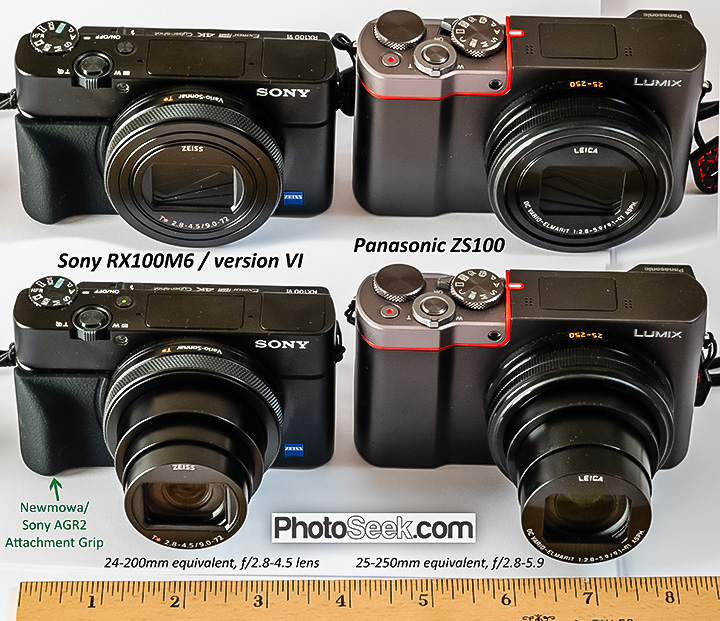
Essential accessories for Sony RX100 VI / RX100M6
- Avoid dropping its slippery body by adding Sony AG-R2 attachment grip.
- Fit into Tamrac Digital 1 Photo Bag with extra Wasabi Power NPBX1 batteries.
- Avoid LCD scratches with QIBOX Premium GLASS Protector to preserve resale value.
- SanDisk Extreme PRO 128GB UHS-I/U3 SDXC Flash Memory Card (Amazon)
Best rivals: cheaper pocketsize travel cameras
If Sony RX100M6 seems too pricey, consider the following cheaper options which beat rivals at their given price points:
- Panasonic Lumix DSC-ZS100 (2016, 11 oz, 25-250mm equivalent lens f/2.8-5.9) far exceeds smartphone resolution. Read my ZS100 review.
- Panasonic Lumix DC-ZS200 (2018, 12 oz, 24-360mm equivalent lens f/3.3-6.4) outguns all pocketable 1″-sensor rivals with a versatile 15x zoom, but sibling ZS100 is sharper and brighter through 10x.
- Sony Cyber-shot DSC-RX100 versions IV, III, II, or I,
within its limited 3x zoom, is sharper and brighter than that sub-range of Panasonic’s 10x-zoom ZS100. Save money with used or earlier III, II or I versions — read Tom’s Sony RX100 III review.
- Best value pocketable superzoom: Panasonic Lumix DMC-ZS70 (2017, 11.4 oz, 24–720mm equiv 30x zoom, 20mp, EVF) beats smartphone image quality. Or save on older ZS60
.
Sony’s “Eye AF” feature: superb autofocus tracks human eyes
For reliably sharper people photography, automatically focusing on human eyes for action and portraits, use Sony’s Eye AF to override your chosen AF area, by holding down the CENTER key on RX100M6. Eye AF works great for sports photography, even at telephoto. This new autofocus paradigm beats most other camera brands. To optimize button placement, I reassigned Eye AF to the C key (garbage can icon), and reassigned CENTER key to AEL toggle (Autoexposure Lock):
- MENU > Tab 2 > List#9 > Custom Key for still photos > C Button > Eye AF
- MENU > Tab 2 > List#9 > Custom Key for still photos > Center Button > AEL toggle.
RX100M6 improves focus acquisition speed to 0.3s versus 0.5s on the previous RX100 version 5. Eye AF is twice as fast. It is the first RX100 camera to include Sony’s High-density Tracking AF technology, where more points are concentrated around the subject to improve AF accuracy for moving subjects.
Recommended settings for Sony RX100 VI / RX100M6
- MENU > Tab 1 > List#1 > File Format > RAW: is for advanced photographers using a raw file editor workflow system, such as Adobe Lightroom CC Classic. In my workflow, I don’t like “RAW+JPEG“, which creates unneeded extra files. “JPEG‘ has insufficient editing leeway for me; but if you choose to keep it as the default, select JPEG Quality = Extra Fine.
- MENU > Tab 1 > List#4 > Focus Mode > [AF-S or AF-A or AF-C or DMF or MF] but I usually prefer DMF:
- MENU > Tab 1 > List#4 > Focus Mode > DMF (Direct Manual Focus): is like AF-S except after shutter button half-presses to lock AF, turning the lens ring then magnifies the subject to confirm what’s in focus. On List#11, set Focus magnif. Time = 2 or 5 Seconds.
- MENU > Tab 1 > List#6 > Face Prty in Mlti Mtr = ON: measures brightness based on detected faces when [Metering Mode] is set to [Multi].
- MENU > Tab 1 > List#11 > MF Assist > On: in MF (Manual Focus) mode, turning lens ring magnifies subject to confirm what’s in focus (as in DMF). Set Focus magnif. Time = 2 or 5 Seconds.
- MENU > Tab 1 > List#11 > Peaking Setting > Peaking Display On [with defaults Mid & White]: flashes edges where focus is sharpest in the frame.
- MENU > Tab 2 > List#5 > Release w/o Card > Disable: because we don’t want shooting effort wasted; we want to be prompted to put in a recordable memory card if not present.
- MENU > Tab 2 > List#7 > Zebra Setting > On, Level 100+ for RAW; 70 for JPEG: indicates overexposed areas with zebra stripes.
- MENU > Tab 2 > List#7 > Grid Line > Rule of 3rds Grid
- MENU > Tab 2 > List#9 > Function Menu Set: Lets you set the two rows of quick-access settings assigned to the Fn (Function) button. I like Fn = Drive Mode, Focus Mode, Focus Area, Touch Operation, ISO, Metering Mode, Flash Mode, Flash Comp, White Balance, Peaking Display, Zebra Display, ISO AUTO Min. SS
- MENU > Tab 2 > List#10 > Audio signals = Off: to quiet the annoying beeps, better for non-intimidating people photos.
- MENU > Tab 5 > List#5 > Date/Time Setup: always check if camera is set to the local time of day, especially if in your editing process you mix shots from two or more cameras.
- MENU > Tab 5 > List#5 > Area Setting: if the minutes are set correctly in Date/Time, change the Area Setting each time you shoot in a new time zone, as a quicker way to set the hour.
- MENU > Tab 5 > List#5 > Format: erases memory card; only format card after several backups have been made.
Sony RX100M6 at 200mm beats Panasonic ZS100 at 250mm & 200mm
The following test shows that a Sony RX100M6 image shot at 200mm equivalent telephoto beats Panasonic ZS100’s quality at 250mm or 200mm. RX100M6’s sharper 200mm shots can simply be digitally enlarged to beat ZS100’s 250mm equivalent zoom.
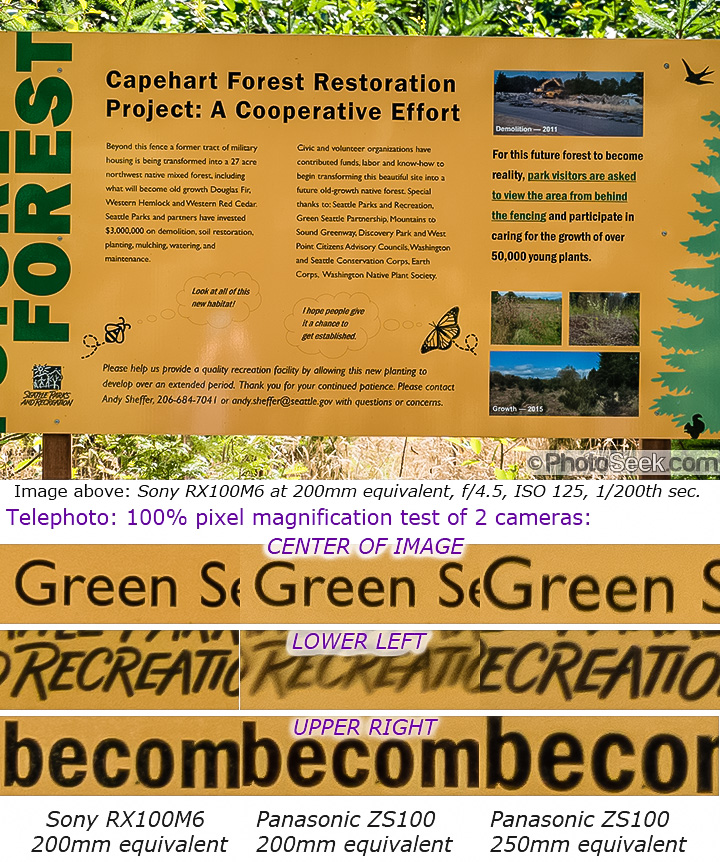
Compared to a 37-ounce Sony RX10M4 camera, the pocketable 11-ounce Sony RX100M6 has the same sensor and nearly equal image quality up to 200mm equivalent. Or a pocketable Panasonic ZS100 costs half as much as RX100M6 and is nearly as sharp at center (but not at edges). In this duck example, compare 200mm and 250mm from two pocket cameras versus 600mm from RX10M4:
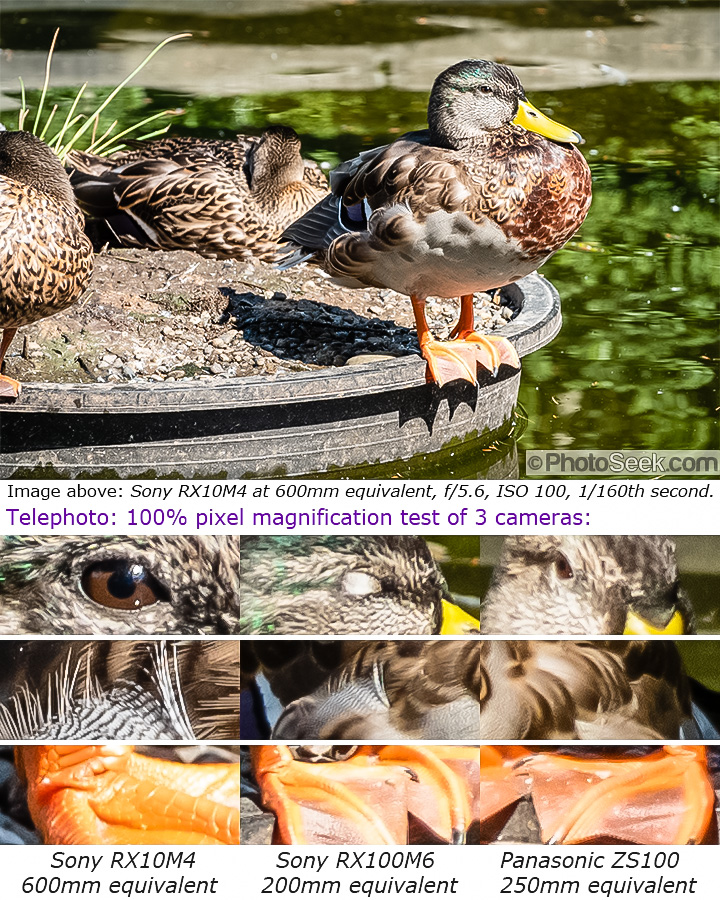
Panasonic ZS100 captures macro shots superior to RX100M6
Although Sony RX100M6/VI can focus sharply beyond 12-24+ inches from the lens, it captures poor macro quality around the edges of the frame at 3.15-inch (8 cm) closest focus. It enlarges biggest at 50mm equivalent zoom. Closely-focused subjects will be sharp at the center of the frame, but can be very blurred around the edges, which can actually help to isolate the center subject, popping it away from the background. But copy work of small flat subjects such as printed text will have unacceptably fuzzy edges. See magnification test images below.
As a workaround for better macro, try:
- A good smartphone with 2x tele second back camera, as in Samsung Galaxy S9+ or my Note9 (Amazon).
- Earlier Sony sibling cameras RX100M5, RX100M4 or RX100M3.
- Larger Sony RX10M4 or RX10M3 cameras with superior macro at 400-600mm f/5.6 and also fun results at 24-90mm. Read my RX10M4 review.
- Excellent Panasonic ZS100 macro at 45mm equivalent. Fitting handily into a shirt pocket, Panasonic ZS100 enlarges best at 45mm equivalent. This optimum setting is very sharp and rectilinear from edge-to-edge, although the subject must be very close to the front of the lens, sometimes overshadowed. At 25mm, f/5.9 is sharper than f/3.5, but edges are still much too soft. For optimal close focus, zoom to 45mm equivalent and don’t forget to press the Flower Button (Macro, Left Arrow).
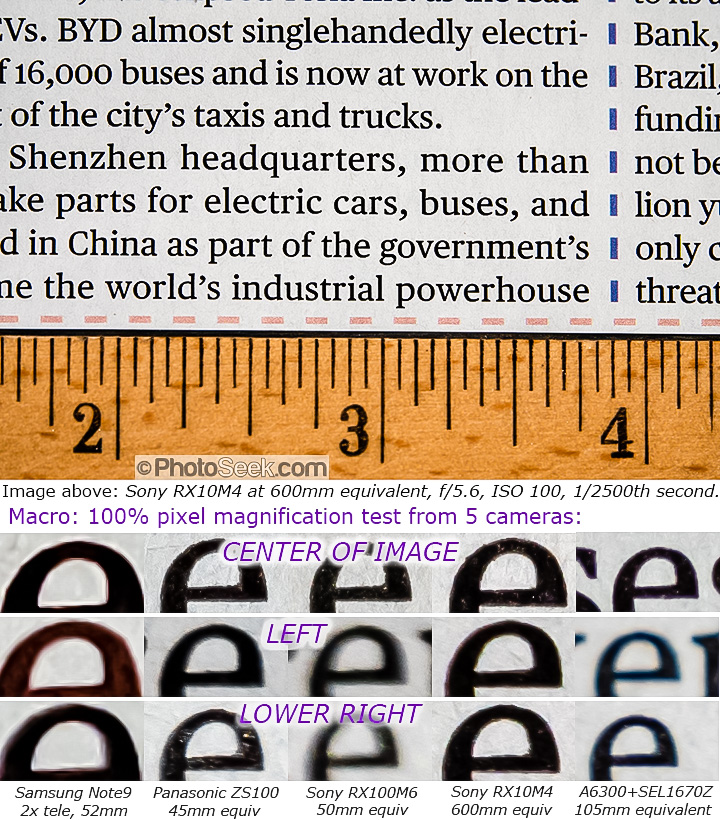
50mm lens test in dim indoor light
Below, five cameras tested with 50mm equivalent lenses in dim indoor light are compared at 100% pixel magnification. All were shot in raw format and optimized similarly in Lightroom.
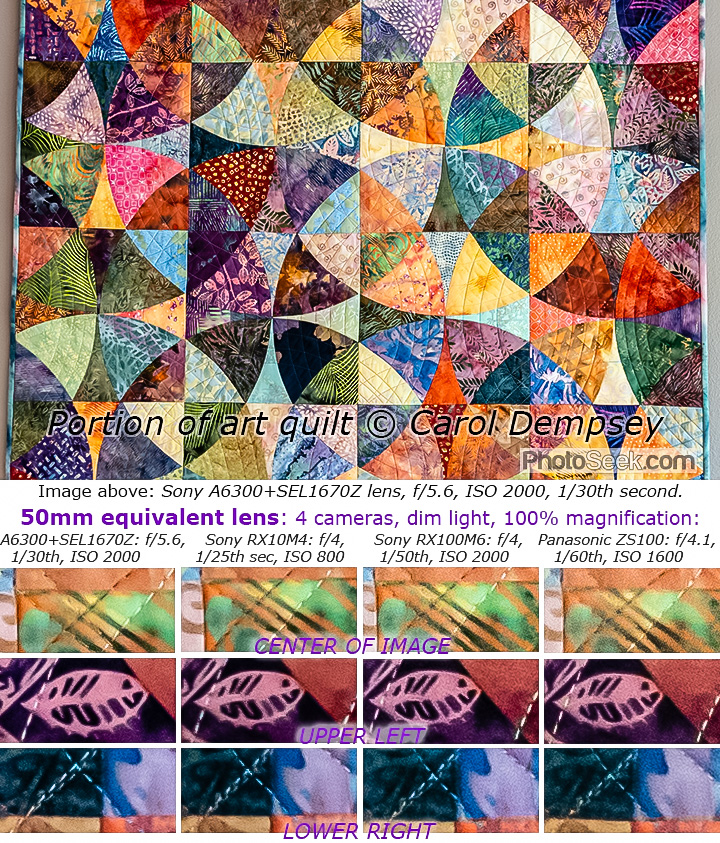
Results: Best image quality at 50mm equivalent in dim light is captured in the following order:
- The 4x zoom SEL1670Z lens on Sony A6300 does best.
- The 25x zoom Sony RX10M4 looks almost as good.
- The 8x zoom Sony RX100M6/VI has only slightly more noise than RX10M4, which could be fixed by shooting at ISO 800 instead of 2000. Impressive results from a camera weighing one third as much!
- The 10x zoom Panasonic ZS100, cheapest of the four, places last. Despite its noisier, lower-contrast results, ZS100 still captures decent quality, for less than half the price of any of the other three cameras.
Evocative images can be created with any camera. For travel, I recommend any of these good-quality zooms having at least 8x range for greater compositional flexibility.
“Best” compact, regardless of price. Some of the most famous photographs in history were never scrutinized for technical excellence and, in fact, they were all made using inferior equipment. This is where our rational brain falters with the ease of access to online retailers like Amazon and Ebay. I’m sure the latest Leica Q is better than all of these cameras combined. Just kidding. Not really, my mouse button is ready to click “buy” right now. But what fun is that?
Still happy with Olympus SZ30 MR
Hi Tom,
I have just discovered you very informative website, all fascinating, thank you.
Just one question before I take the plunge:
Would the RX100 M6 or 7 produce images of sufficient quality to produce post cards, small tourist booklets and the occasional framed print up to A3 in size.
If you can spare the time for a comment I would greatly appreciate it.
Many thanks
John
Yes, the pocketable Sony RX100 M6 or 7 camera will certainly capture sufficient quality to produce post cards, small tourist booklets and framed prints of A3 size and larger.
In fact, its enlargement size is virtually unlimited, so long as the print’s viewing distance exceeds about the length of the longest side of the image.
After several years of use, my RX100 M6 (throughout its 8x zoom) has served well to capture publishable images equal in quality to my much larger Sony RX10M4 camera (whose advantage is adding extra optical zoom through 25x).
Both cameras greatly exceed the quality captured from any of my former film cameras.